Sun - April 25, 2010
Admiration for Horton
And even some sympathy for Maysie, from observing
a nesting mallard
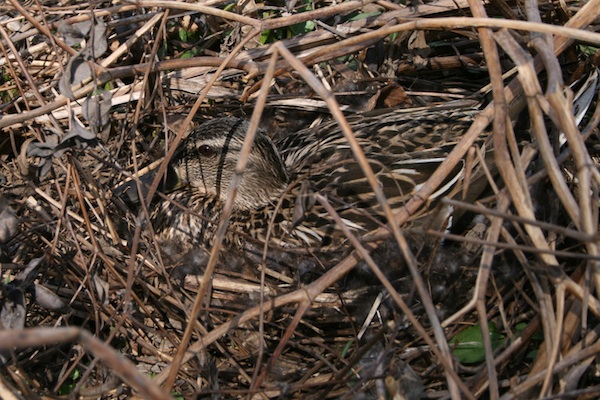
Around April first, I discovered a duck nest, with eggs, in our prairie garden. While clearing brush from the garden, I had unwittingly removed the dried stalks of false blue indigo (Baptisia australis) that had covered it. I had actually been watching for such a nest, because the same thing happened in 2008, and I didn't really want to repeat my blunder, but the camouflage fooled me. I tried to replace the nest's shelter with a haphazard arrangement of plant stems, and hoped I hadn't done too much damage. I was relieved to see the mother incubating her eggs a few days later, and I've been checking on her for three weeks now.
She has been on the nest every time I've checked, usually several times each day. A few days ago I set up a spotting scope on our porch, about 25 yards away, so I could easily check on her more often. It's been a relatively mild spring, but she has nevertheless endured frost, rain and even some pea-sized hail. Day after day, she patiently sits, sometimes repositioning herself, or doing a little preening, or some rearranging of nest material, but never leaving as far I can tell.
The incubation period for mallards is about four weeks, so I expect the eggs to hatch later this week. As I understand it, the ducklings typically leave the nest within 24 hours of hatching, so we'll have to be vigilant to avoid missing them. I'll be collecting photos.
Update: At around 7:00 the morning after I wrote this item, I found the nest unoccupied. While I was peering into the nest to try to count the mostly-covered eggs (looked like at least four), a pair of mallards flew into the yard. I moved away from the nest, and by the time I was in the house the mother duck was heading over to the nest. So she actually does leave sometimes, meeting up with the presumed father.
Update 2: On the morning of 30 April, we saw ducklings at the nest. I managed to get some pictures (through the spotting scope) in which they can just barely be seen. I've added these to our Prairie Garden Duck Nest gallery on smugmug.
Posted at 03:19 PM Read More
Sun - July 12, 2009
Loon Song (and Dance)
While we were kayaking on a lake in northern
Minnesota, a pair of loons provided entertainment.
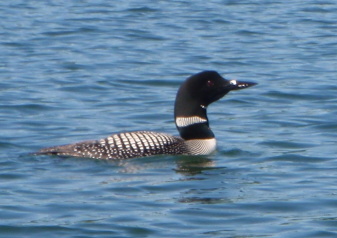
Over the Independence Day weekend, we were the guests of gracious friends at their lake place. We had a great time, and one of the many fine experiences occurred on Sunday morning while we were paddling about on the lake. A pair of loons showed up, calling back and forth almost continuously, and one of them did a brief dance routine while I was shooting video.
You can see and hear a one-minute loon video (about 6.5 megabytes), or a tiny version that loads quickly (about half a megabyte). (Please excuse the bits of noise I made. I need to learn to keep quiet while recording.)
Let me know if you have any trouble viewing these, and I'll try other formats (or I'll resort to YouTube).
Update: I added the photo above, and there are a few more pictures from our weekend on SmugMug.
Posted at 10:44 AM Read More
Sun - October 26, 2008
Bringing Cell Biology to Life
A stunningly beautiful animation shows examples
of activity within living cells.

Yesterday I came across a video called The Inner Life of a Cell from the BioVisions program at Harvard University. This is an amazing piece of animation that shows details of the inner workings of living cells, down to the scale of proteins. There are two very different versions, each valuable in its own way.
One shows about eight minutes of beautiful but unexplained video, with a fine musical background. I recommend starting with this delightful version. If you know anything about cell biology, you will recognize some things, but may be puzzled (or even mystified) by others. In any case, I think you'll find it astonishing.
If you'd like some explanation of what you're seeing, there is another version without music, but with voice-over and some text labels. (Choose one of the "Inner Life" images, based on your connection speed. The "super speed" version took some minutes to load over my DSL connection.) Some of the description is rather advanced, and was beyond me, but you are likely to gain insight from parts of it.
While this animation may be scientifically accurate in many ways, it is necessarily rather schematic in other ways, for the sake of making it comprehensible. Many of the structures are set apart from each other using color, though they are too small for visible-light color to be physically meaningful. The scenes show particular molecules interacting, but omit a sea of others that would obscure the interaction.
There is also little hint of the time scale. Some of the most striking scenes show examples of a kind of molecular motor, kinesin molecules, that move vesicles by "walking" along microtubules (as in the image above). I was curious about their actual pace, so I searched for additional information and learned that they evidently execute about 100 "steps" per second! Each step generally uses the energy from one ATP molecule, and advances just eight nanometers.
Posted at 01:45 PM Read More
Sun - July 29, 2007
The Unglamorous Life of a Tiny Hermit
Another prairie-garden item, this time
about a certain mysterious insect
One day last summer after I had been out in my
prairie garden, I found a strange little insect clinging to my clothing. It
appeared to be living in a rigid little case, carrying this shell-like enclosure
as it walked about. I had never heard of such a creature. I knew about caddis
flies, whose larvae build cases out of small sticks or stones, but they are
aquatic, and there was little water in the prairie garden on that dry summer
day. To have some hope of figuring out what this tiny creature was, I tried to
get a few pictures of it, though I'm not yet well equipped for macro photography
on the scale of this bug, which was only about an eighth of an inch long --
including its case. I managed to get a few shots that I could crop down to
images that would serve as fair portraits, despite rather poor focus. Here's
one of
them:
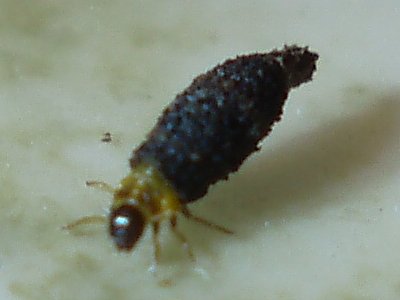
I really had no idea what this was, or even whether its little case was something it constructed, or something (maybe a seed pod) that it had just moved into, as a hermit crab does with a shell it finds. I posted my few photos on smugmug, hoping that someone I knew might have some ideas, but we had little to go on.
This summer I found more of these little beasts, all of them perched on goldenrod plants in the garden. I did some searching of Internet insect-identification sites such as www.whatsthatbug.com and bugguide.net, but I didn't manage to find what I was looking for. I did get a few somewhat-improved photos. In the first one below, I'm holding the case between my fingertips, and the insect is extended pretty far, investigating its entrapment. In the second, it's walking across the palm of my hand.
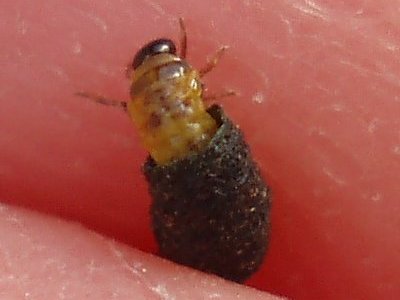
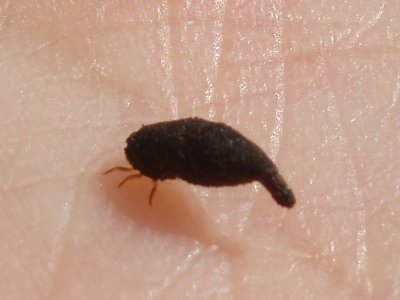
A few weeks ago, my son John (a biology grad student) was in town, and he managed to find information about insects known as casebearers, a subfamily (Cryptocephalinae) of leaf beetles whose photos and descriptions matched my little hexapod friends. The larvae of these beetles do indeed construct and live in cases -- made out of their fecal matter!
Some of these casebearers belong to a group known as warty leaf beetles (the tribe Chlamisini), and the photos of the adults in this group looked familiar. I had seen one or two similar beetles on the same goldenrod plants, so we concluded that our casebearers were maturing into these adult beetles, leaving their ignoble enclosures behind. But these adults are hardly more glamorous than in their earlier form. They are small, dark, and lumpy-looking, as the next photo shows:
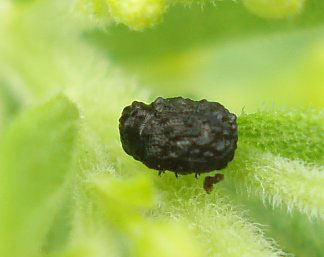
Descriptions of these bumpy little beasts note that they resemble frass (an entomological euphemism for caterpillar droppings), and one writer claimed he had seen bits of frass in insect collections, mounted and labeled as warty leaf beetles. This humble disguise presumably provides these little creatures with some protection from being consumed.
I still don't know precisely what species I've got in my garden, as there are dozens of species of warty leaf beetles in several genera. Most feed on particular kinds of plants, but it seems that goldenrods host a number of species. Nevertheless, I'm happy to know the "tribe" they belong to, and to have learned a little more about these humble creatures that advance from living in droppings to merely looking like droppings.

I really had no idea what this was, or even whether its little case was something it constructed, or something (maybe a seed pod) that it had just moved into, as a hermit crab does with a shell it finds. I posted my few photos on smugmug, hoping that someone I knew might have some ideas, but we had little to go on.
This summer I found more of these little beasts, all of them perched on goldenrod plants in the garden. I did some searching of Internet insect-identification sites such as www.whatsthatbug.com and bugguide.net, but I didn't manage to find what I was looking for. I did get a few somewhat-improved photos. In the first one below, I'm holding the case between my fingertips, and the insect is extended pretty far, investigating its entrapment. In the second, it's walking across the palm of my hand.


A few weeks ago, my son John (a biology grad student) was in town, and he managed to find information about insects known as casebearers, a subfamily (Cryptocephalinae) of leaf beetles whose photos and descriptions matched my little hexapod friends. The larvae of these beetles do indeed construct and live in cases -- made out of their fecal matter!
Some of these casebearers belong to a group known as warty leaf beetles (the tribe Chlamisini), and the photos of the adults in this group looked familiar. I had seen one or two similar beetles on the same goldenrod plants, so we concluded that our casebearers were maturing into these adult beetles, leaving their ignoble enclosures behind. But these adults are hardly more glamorous than in their earlier form. They are small, dark, and lumpy-looking, as the next photo shows:

Descriptions of these bumpy little beasts note that they resemble frass (an entomological euphemism for caterpillar droppings), and one writer claimed he had seen bits of frass in insect collections, mounted and labeled as warty leaf beetles. This humble disguise presumably provides these little creatures with some protection from being consumed.
I still don't know precisely what species I've got in my garden, as there are dozens of species of warty leaf beetles in several genera. Most feed on particular kinds of plants, but it seems that goldenrods host a number of species. Nevertheless, I'm happy to know the "tribe" they belong to, and to have learned a little more about these humble creatures that advance from living in droppings to merely looking like droppings.
Posted at 03:27 PM Read More
Thu - July 26, 2007
Prairie Garden Retrospective
Some photos of our daughter and our
prairie garden 25 years ago
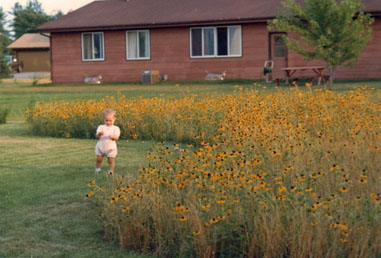
In my last entry I mentioned an old photo of Janice and our prairie garden from 1982. It turns out that the photo I had in mind doesn't exist. It seems to have been a kind of mental composite of three photos shown here. The one above shows most of the garden, with a neighbor's house in the background. Near the center of the left edge you can see a small shrub. This innocent-looking plant is one of the Amur maples that eventually caused problems for the garden (especially after they were more than 15 feet tall).

This next image shows little of the garden, but doesn't Janice look cute?
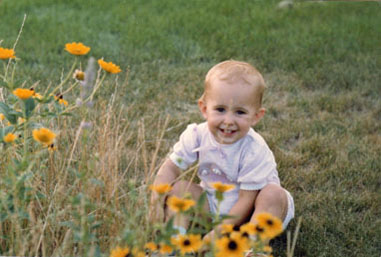
Here's Janice again, with some prairie plants in the foreground (including a grass stem right across her face). Notice that there are actually two kinds of yellow flowers here. The ones with the very dark centers (mostly near the bottom) are black-eyed Susans. The ones with centers that are yellow (but still darker than the surrounding petals) are common ox-eye (Heliopsis helianthoides). This year we've had lots of black-eyed Susans, but only a few ox-eye blossoms so far.
I'll be putting higher-resolution versions of these photos in the Prairie Garden Restoration gallery on smugmug.
Posted at 08:28 PM Read More
Sun - July 22, 2007
Prairie Garden
We're restoring our garden of native
prairie plants.
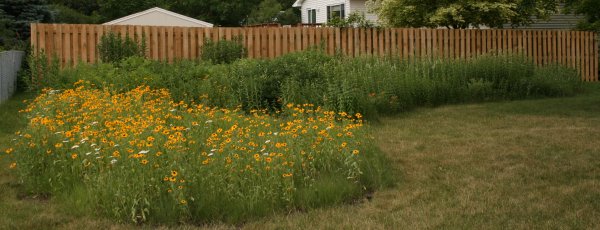
Peg and I have shared an interest in wildflowers since the early years of our marriage, and we developed a particular focus on prairie plants around 1979. In that year that we received a packet of mixed prairie seeds as a gift for joining The Nature Conservancy, and used them to plant a small garden in a corner of our yard. We also attended classes on prairie plants at the Minnesota Landscape Arboretum around that time, and I bought a few potted prairie plants at a plant sale at the arboretum, and added them to the garden.
I think it was in 1981 that Peg and the kids gave me a large package of prairie seed from Prairie Restorations Inc. as a Father's Day present, and we expanded the prairie garden to its present size of roughly a thousand square feet, with about 25 or 30 species of native prairie flowers and grasses.
We added a few more species over the years, but during the 1990s a nearby row of Amur maples shaded out the east end of the garden, nearly eliminating the sun-loving prairie plants in about a third of the total area. A significant number of species eventually disappeared from the rest of the garden as well, though many continued to thrive.
A few years ago we had the overgrown Amur maples removed (though we still have a lovely one in our front yard). We cleared the east end of the garden, and last summer I bought seed for about three dozen prairie species (again from Prairie Restorations), and replanted the cleared area (photos on smugmug). The photo above (from 20 June 2007) shows the replanted area in the foreground. The numerous yellow flowers are black-eyed Susan (Rudbeckia hirta), which is biennial (while most prairie plants are perennial), so it matures more quickly than most of the other species, but will not persist in such numbers.
Somewhere in our disorganized archive of photographic prints is a picture of Janice as a toddler, standing in front of the garden. It must have been 1982, and the expanded garden was at a stage similar to that shown here, with a dense display of black-eyed Susan.
The prairie garden has long been one of my most focused interests, and I've spent quite a bit of time exploring it this summer. I'm collecting some photos that I'll be sharing soon. Also, a few insects in the garden have particularly caught my attention, so I expect to have more to say about them in the coming weeks.
Posted at 05:09 AM Read More
Mon - March 12, 2007
Poets, Beavers and Cities
Two podcasts from last week highlighted
differing attitudes toward urban life.
I was listening to a few podcasts this weekend, and
I was struck by an odd contrast between two of
them.
The latest episode from The Poetry Foundation (March 8, 2007) had the title Get Me Out of Here, and included readings of "Subway Seethe" by J. Allyn Rosser and "Chant" by Tom Sleigh. Both poems expressed frustration with troublesome behaviors that are part of life in cities.
In contrast to this distaste for urban life, the latest episode (March 7, 2007) of Science Talk from Scientific American presented details about the recent discovery that, for the first time in about 200 years, a wild beaver is living in New York City. More specifically, a beaver has built a lodge on a part of the Bronx River that happens to be on the grounds of the Bronx Zoo (but the zoo has no beavers in its collection, so this is not an escapee). The WIldlife Conservation Society has more details and photos available.
The latest episode from The Poetry Foundation (March 8, 2007) had the title Get Me Out of Here, and included readings of "Subway Seethe" by J. Allyn Rosser and "Chant" by Tom Sleigh. Both poems expressed frustration with troublesome behaviors that are part of life in cities.
In contrast to this distaste for urban life, the latest episode (March 7, 2007) of Science Talk from Scientific American presented details about the recent discovery that, for the first time in about 200 years, a wild beaver is living in New York City. More specifically, a beaver has built a lodge on a part of the Bronx River that happens to be on the grounds of the Bronx Zoo (but the zoo has no beavers in its collection, so this is not an escapee). The WIldlife Conservation Society has more details and photos available.
Posted at 07:27 PM Read More
Sat
- March 3, 2007
Neighborhood Eagles
A pair of eagle neighbors stopped by to
pose for pictures this morning.
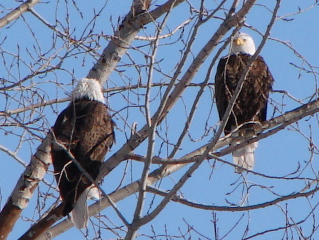
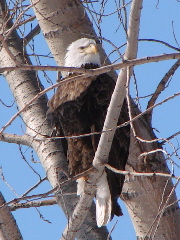
One of the great things about living a mile or so from the Minnesota Valley National Wildlife Refuge is that the wildlife often spills over into our neighborhood. Today it was pair of bald eagles.
When I opened the shade on a front window this morning, I noticed these birds in a cottonwood tree behind the house across the street. We immediately got out our best telephoto lens and began taking pictures. Not knowing how long they might stay around, I quickly took a few pictures (including the first one above) from our driveway, with the camera hand held. We then got our tripod out, and started roving about taking pictures from various vantage points where we could get a view without too many branches in the way. One eagle soon flew off, but settled back on a lower branch. Otherwise, they stayed in place for over an hour, and we got a couple dozen photos that we've posted on our smugmug site.
Posted at 04:50 PM Read More
Quick Links
Calendar
| Sun | Mon | Tue | Wed | Thu | Fri | Sat |
Categories
Archives
XML/RSS Feed
Statistics
Total entries in this blog:
Total entries in this category:
Published On: May 05, 2010 04:54 PM
Total entries in this category:
Published On: May 05, 2010 04:54 PM